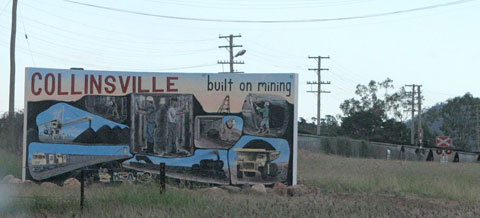 About 80 km south-west of Bowen in Queensland is the historic mining town of Collinsville. They’re proud of their strong coalmining and union past here — as the saga of underground strikes and fatal accidents and protest convoys to Brisbane attests. I know this from the coal museum and their interesting online history site.
About 80 km south-west of Bowen in Queensland is the historic mining town of Collinsville. They’re proud of their strong coalmining and union past here — as the saga of underground strikes and fatal accidents and protest convoys to Brisbane attests. I know this from the coal museum and their interesting online history site.
But the old underground mining methods and the mateship ways ended in the 1990s; now the Collinsville mine is a vast opencut and most of the workers come from outside the area, do their 12-hour shifts for four days, then go home to their families on the coast.
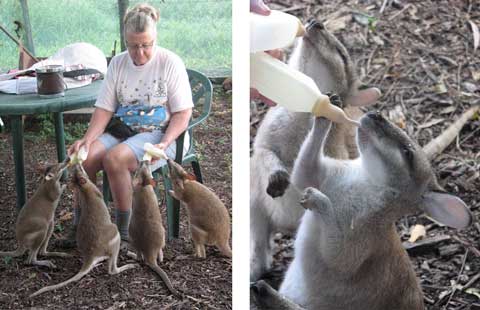 Just west of Collinsville is the tiny village of Scottsville. Here I am to stay with Carol and Vince Cosentino at Wurra Yumba — Kangaroo House — who have a very pleasant accommodation building in their garden, which really belongs to a menagerie of rescued wildlife on the mend.
Just west of Collinsville is the tiny village of Scottsville. Here I am to stay with Carol and Vince Cosentino at Wurra Yumba — Kangaroo House — who have a very pleasant accommodation building in their garden, which really belongs to a menagerie of rescued wildlife on the mend.
It is often used by backpackers, whom I imagine would be fascinated by Carol’s varying ages and breeds of wallaby joeys, all with large and thoughtfully planned play areas and with their own night-time racks of colourful sling bag/pouches.
Before I leave in the morning I watch Carol give the morning feed to this appealing group of young Pretty-face Wallabies who had slept — slung — just outside my door. As you can see, she can always use an extra pair of hands! When the slower ones emerge for breakfast, she has to use her knees as well as hands to hold the bottles.
This is merely one of many groups. Carol gets no funding for her rescue and rehabilitation work, which includes birds as well as other mammals. Feed and formula bills are huge, let alone all the incidentals, and the constant restructuring of the space to better cater for her charges’ needs. Husband Vince helps with the latter work, while donations for the occasional accommodation might cover the tonnes of tissues Carol must use, from what I saw!
You can reach Carol at Wurra Yumba on 07 4785 5497 or visit her website.
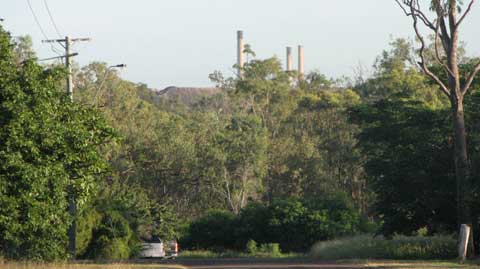 But it is actually Carol’s village of Scottsville that is closest to the Collinsville opencut mine.
But it is actually Carol’s village of Scottsville that is closest to the Collinsville opencut mine.
 At night, a drive along a hilltop road revealed how huge this mine is, or so I thought; but satellite maps show me it is far bigger.
At night, a drive along a hilltop road revealed how huge this mine is, or so I thought; but satellite maps show me it is far bigger.
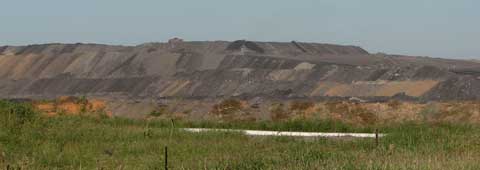 And the newer Sonoma mine is far too close as well. There has been a coal-fired power station here since 1976, and with what I know from the Hunter, the combination does not augur well for the health of Scottsville and Collinsville residents.
And the newer Sonoma mine is far too close as well. There has been a coal-fired power station here since 1976, and with what I know from the Hunter, the combination does not augur well for the health of Scottsville and Collinsville residents.
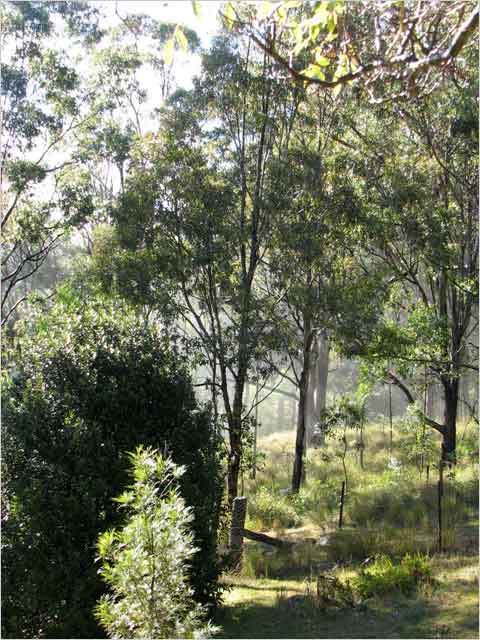
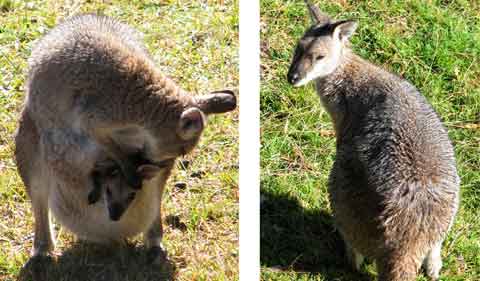

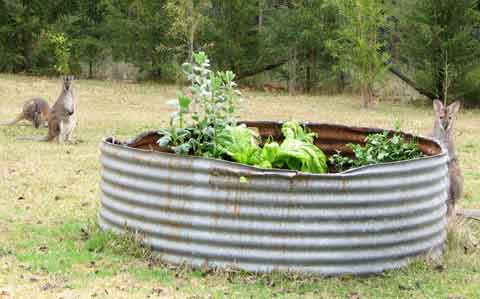
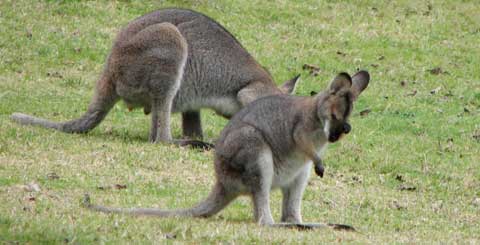
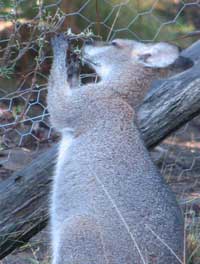 Home on the mountain at last, I was greeted by a heavily pruned garden ruled by wallabies.
Home on the mountain at last, I was greeted by a heavily pruned garden ruled by wallabies. 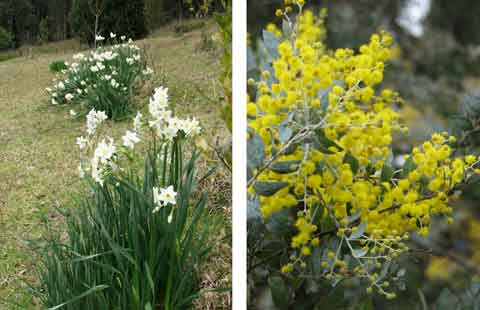
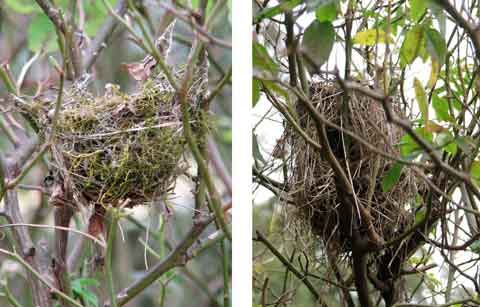
 About 80 km south-west of Bowen in Queensland is the historic mining town of Collinsville. They’re proud of their strong coalmining and union past here — as the saga of underground strikes and fatal accidents and protest convoys to Brisbane attests. I know this from the coal museum
About 80 km south-west of Bowen in Queensland is the historic mining town of Collinsville. They’re proud of their strong coalmining and union past here — as the saga of underground strikes and fatal accidents and protest convoys to Brisbane attests. I know this from the coal museum  Just west of Collinsville is the tiny village of Scottsville. Here I am to stay with Carol and Vince Cosentino at Wurra Yumba — Kangaroo House — who have a very pleasant accommodation building in their garden, which really belongs to a menagerie of rescued wildlife on the mend.
Just west of Collinsville is the tiny village of Scottsville. Here I am to stay with Carol and Vince Cosentino at Wurra Yumba — Kangaroo House — who have a very pleasant accommodation building in their garden, which really belongs to a menagerie of rescued wildlife on the mend. But it is actually Carol’s village of Scottsville that is closest to the Collinsville opencut mine.
But it is actually Carol’s village of Scottsville that is closest to the Collinsville opencut mine. At night, a drive along a hilltop road revealed how huge this mine is, or so I thought; but satellite maps show me it is far bigger.
At night, a drive along a hilltop road revealed how huge this mine is, or so I thought; but satellite maps show me it is far bigger. And the newer Sonoma mine is far too close as well. There has been a coal-fired power station here since 1976, and with what I know from the Hunter, the combination does not augur well for the health of Scottsville and Collinsville residents.
And the newer Sonoma mine is far too close as well. There has been a coal-fired power station here since 1976, and with what I know from the Hunter, the combination does not augur well for the health of Scottsville and Collinsville residents.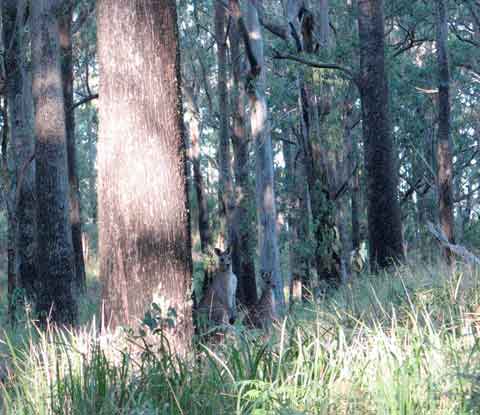 Out in the real forest it is always a matter of double-take with our cleverly camouflaged creatures; I think I see a dark shadow sway, a tree trunk bend. Kangaroo? Wallaroo? One blink and they might be gone.
Out in the real forest it is always a matter of double-take with our cleverly camouflaged creatures; I think I see a dark shadow sway, a tree trunk bend. Kangaroo? Wallaroo? One blink and they might be gone.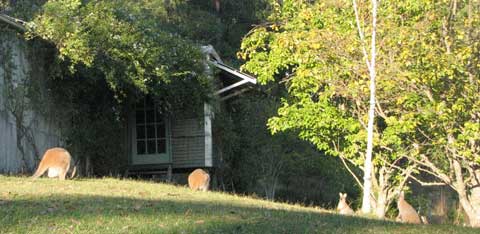 But now that my house yard is their territory too, I get different, more domestic views of my macropod neighbours. In the early mornings, as the sun begins to soak up the dew and highlight the trees, it now also picks out fluffy ears, closed sundrowsing eyes, busily feeding backs, and the many babies, cosily enpouched or skittishly out-pouched.
But now that my house yard is their territory too, I get different, more domestic views of my macropod neighbours. In the early mornings, as the sun begins to soak up the dew and highlight the trees, it now also picks out fluffy ears, closed sundrowsing eyes, busily feeding backs, and the many babies, cosily enpouched or skittishly out-pouched.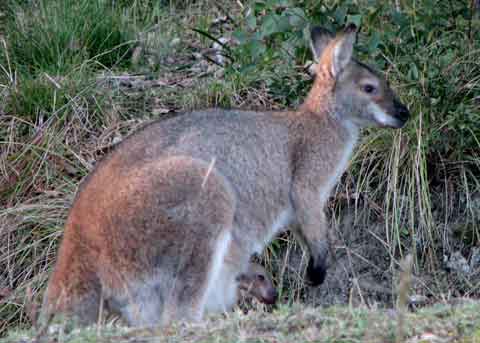
 Now that all the Refuge animals have free run of my house yard, it’s been interesting to see the sharing arrangements develop, both with me as the sole human, and with the other, better adapted, species.
Now that all the Refuge animals have free run of my house yard, it’s been interesting to see the sharing arrangements develop, both with me as the sole human, and with the other, better adapted, species.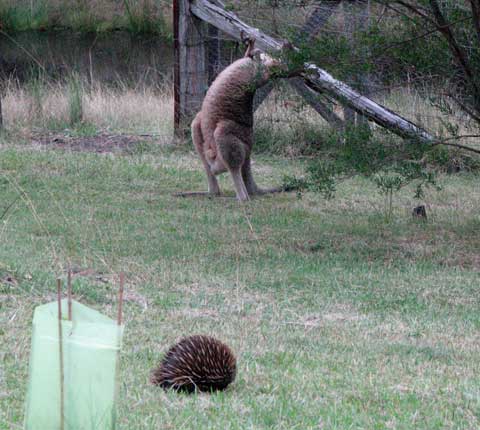 But they are an amiable breed, and co-exist happily with anyone else, even me. This wallaby with the itchy tummy is almost overbalancing as he scratches, with no thought of the echidna that trundles past, intent on its own business.
But they are an amiable breed, and co-exist happily with anyone else, even me. This wallaby with the itchy tummy is almost overbalancing as he scratches, with no thought of the echidna that trundles past, intent on its own business.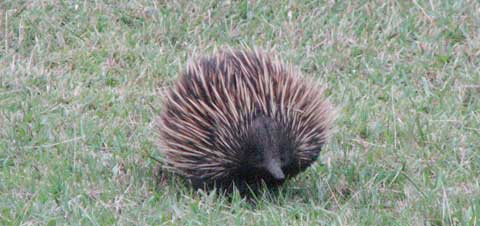 I have learnt that minding one’s own business is the key for my survival here too — not that interfering with an echidna would be on my mind!
I have learnt that minding one’s own business is the key for my survival here too — not that interfering with an echidna would be on my mind! My house wallaby’s joey is venturing more than its head out now. From the low-slung safety and warmth of the pouch, it projects its front legs and paws, touching the grass.
My house wallaby’s joey is venturing more than its head out now. From the low-slung safety and warmth of the pouch, it projects its front legs and paws, touching the grass.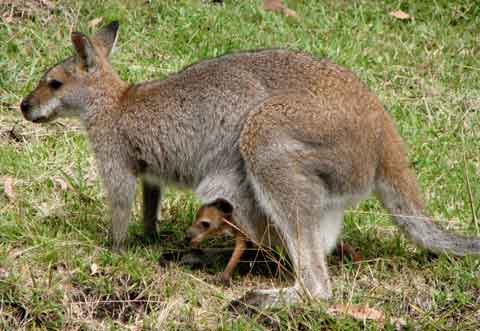 Big soft ears turning, nose sniffing, eyes alert, our joey is growing up fast. Its fur is still fine, not enough to keep it warm in these 10-14 degree autumn days. On the cusp of babyhood, it has the best of both inside and outside worlds, able to try touch and taste, but retreat to snooze, suckle and be safe.
Big soft ears turning, nose sniffing, eyes alert, our joey is growing up fast. Its fur is still fine, not enough to keep it warm in these 10-14 degree autumn days. On the cusp of babyhood, it has the best of both inside and outside worlds, able to try touch and taste, but retreat to snooze, suckle and be safe.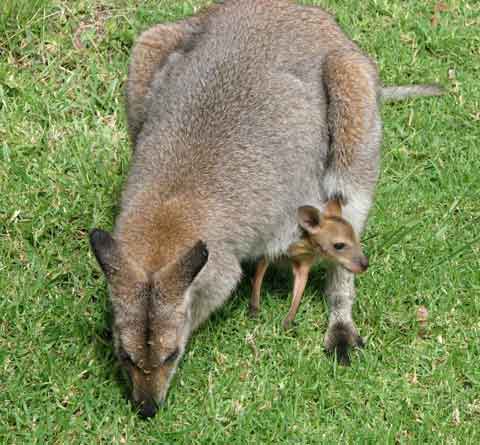 I am always astonished at how big the joeys are when their mothers continue to allow them to ride in the pouch. This one has a way to grow yet the pouch is barely clearing the ground now. Tussock country can’t be easy with a gangly joey swinging below.
I am always astonished at how big the joeys are when their mothers continue to allow them to ride in the pouch. This one has a way to grow yet the pouch is barely clearing the ground now. Tussock country can’t be easy with a gangly joey swinging below.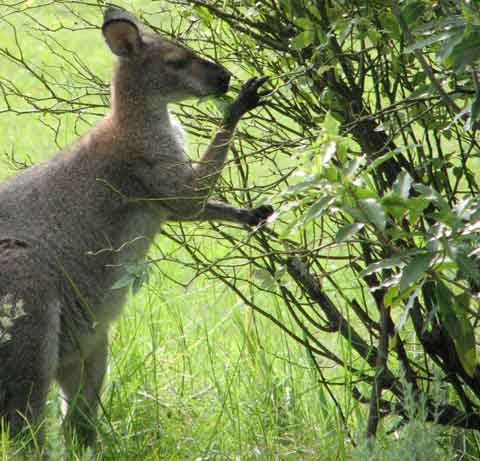 It hasn’t taken long for the wallabies to make themselves at home in the house yard. The roses are the main feeding attraction, with them stripping all the smaller bushes, and making considerable effort to reach up and pull down the stems of higher ones, like the old shrub rose, Autumnalis, and the Banksia Rose.
It hasn’t taken long for the wallabies to make themselves at home in the house yard. The roses are the main feeding attraction, with them stripping all the smaller bushes, and making considerable effort to reach up and pull down the stems of higher ones, like the old shrub rose, Autumnalis, and the Banksia Rose. The other quickly-acquired daily habit is occupying shady spots– one each, probably claimed and kept. The shade may be quite small, from a single shrub, or from man-made objects like the barbeque.
The other quickly-acquired daily habit is occupying shady spots– one each, probably claimed and kept. The shade may be quite small, from a single shrub, or from man-made objects like the barbeque. I do like seeing them so relaxed when I am about, and I am learning to unclench my teeth and be more relaxed myself when I see them eating the roses — or the Robinia — or the Buddleia — or the grapevines. A new era, I keep telling myself, and I chose it. So get used to it and enjoy!
I do like seeing them so relaxed when I am about, and I am learning to unclench my teeth and be more relaxed myself when I see them eating the roses — or the Robinia — or the Buddleia — or the grapevines. A new era, I keep telling myself, and I chose it. So get used to it and enjoy!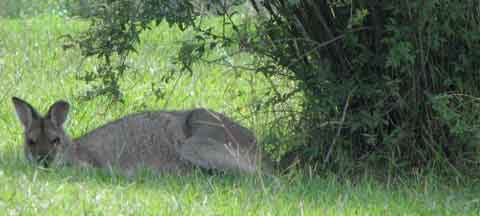
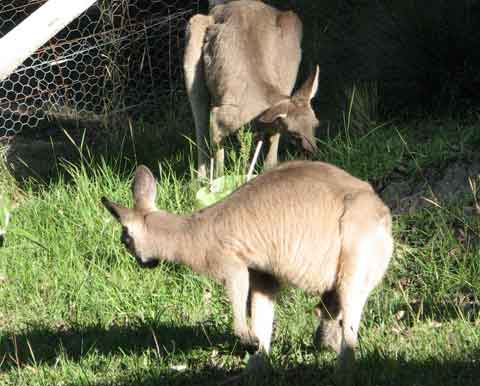 One late afternoon I opened all four gates into the house yard. You will not have your wallaby photos obscured by netting from now on.
One late afternoon I opened all four gates into the house yard. You will not have your wallaby photos obscured by netting from now on.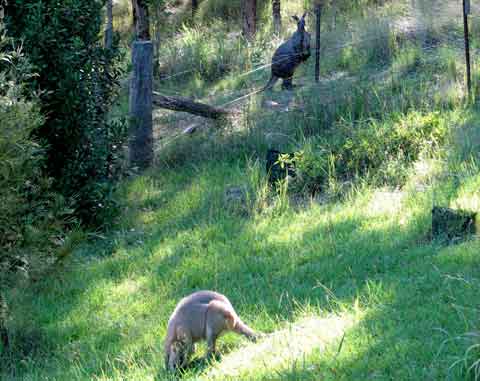 Slowly they ventured in. Wallabies first. The wallaroo looked on disapprovingly from outside the fence, where he stayed. Kangaroos are coming in too, but not close yet.
Slowly they ventured in. Wallabies first. The wallaroo looked on disapprovingly from outside the fence, where he stayed. Kangaroos are coming in too, but not close yet. Soon they were everywhere, and over the next few days some began to rest inside the yard, using the shade of buildings and trees during the day. Some were more calm than others, some staying still as I walked past, others bolting in panic.
Soon they were everywhere, and over the next few days some began to rest inside the yard, using the shade of buildings and trees during the day. Some were more calm than others, some staying still as I walked past, others bolting in panic.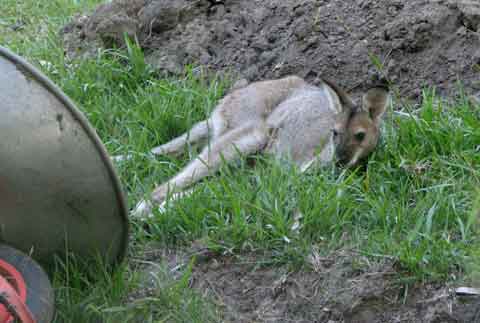 I immediately cleaned some strategic windows so I could take photos, like this laid-back wallaby. I enjoy observing the process of familiarisation. This is a new era of living here for me — and my neighbours.
I immediately cleaned some strategic windows so I could take photos, like this laid-back wallaby. I enjoy observing the process of familiarisation. This is a new era of living here for me — and my neighbours.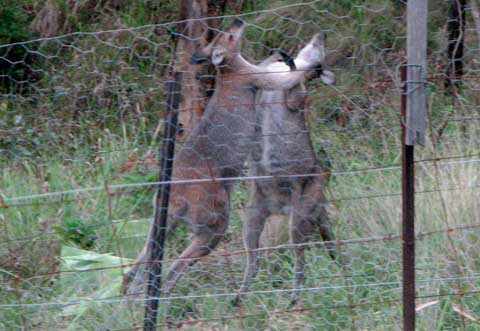 These two males were in a group that was following a young female down the hill past my yard. For some reason — a muttered slight on the lady’s honour or the the rival’s virility? — they broke off the pursuit and began fighting.
These two males were in a group that was following a young female down the hill past my yard. For some reason — a muttered slight on the lady’s honour or the the rival’s virility? — they broke off the pursuit and began fighting.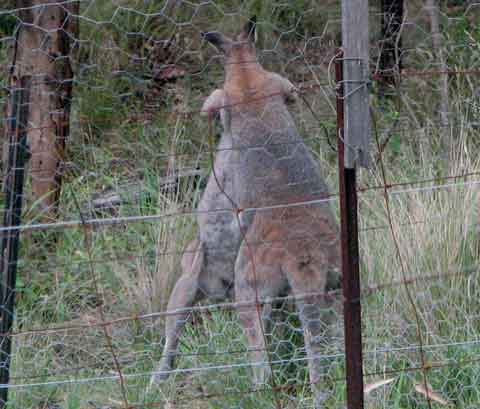 Their necks look vulnerable in the position they assume, but it must be against the rules to go for the throat. The pair of them kept it up as they danced through the tussocks, turning and tumbling down the slope to the gully, out of my sight.
Their necks look vulnerable in the position they assume, but it must be against the rules to go for the throat. The pair of them kept it up as they danced through the tussocks, turning and tumbling down the slope to the gully, out of my sight. On a recent damp day, as the wallabies grazed past the house fence, one female seemed to have a light stripe across the nose.
On a recent damp day, as the wallabies grazed past the house fence, one female seemed to have a light stripe across the nose. After watching for a while as she fed and bent up and down and scratched and twisted about, I fetched the camera to zoom closer and try to determine if it was a scar or no.
After watching for a while as she fed and bent up and down and scratched and twisted about, I fetched the camera to zoom closer and try to determine if it was a scar or no.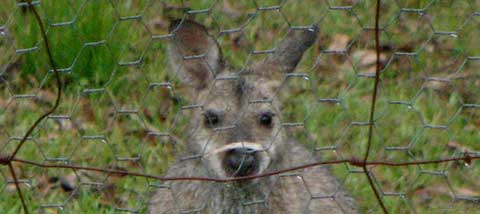 Closer still, it was revealed as a dead leaf — a damp dead leaf, pasted firmly across her nose by the rain.
Closer still, it was revealed as a dead leaf — a damp dead leaf, pasted firmly across her nose by the rain.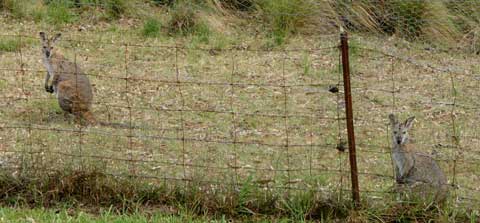 The dainty Red-necked Wallabies are my most common marsupial here, and I daily see small groups grazing along the yard fence line, not far from my verandah. When I appear, they usually look up to see what I’m doing, then it’s heads back down to resume eating.
The dainty Red-necked Wallabies are my most common marsupial here, and I daily see small groups grazing along the yard fence line, not far from my verandah. When I appear, they usually look up to see what I’m doing, then it’s heads back down to resume eating.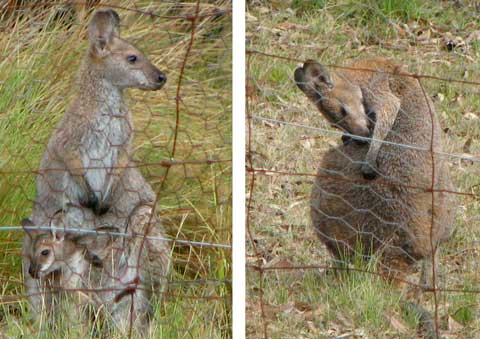 Often the Red-necked Wallaby mothers that I see here seem far too small to be mothers. By the time the joey is old enough to stay out of the pouch it is nearly as big as its mum. This one (left) wasn’t venturing out today but it was leaning out and doing a bit of practice grazing.
Often the Red-necked Wallaby mothers that I see here seem far too small to be mothers. By the time the joey is old enough to stay out of the pouch it is nearly as big as its mum. This one (left) wasn’t venturing out today but it was leaning out and doing a bit of practice grazing.